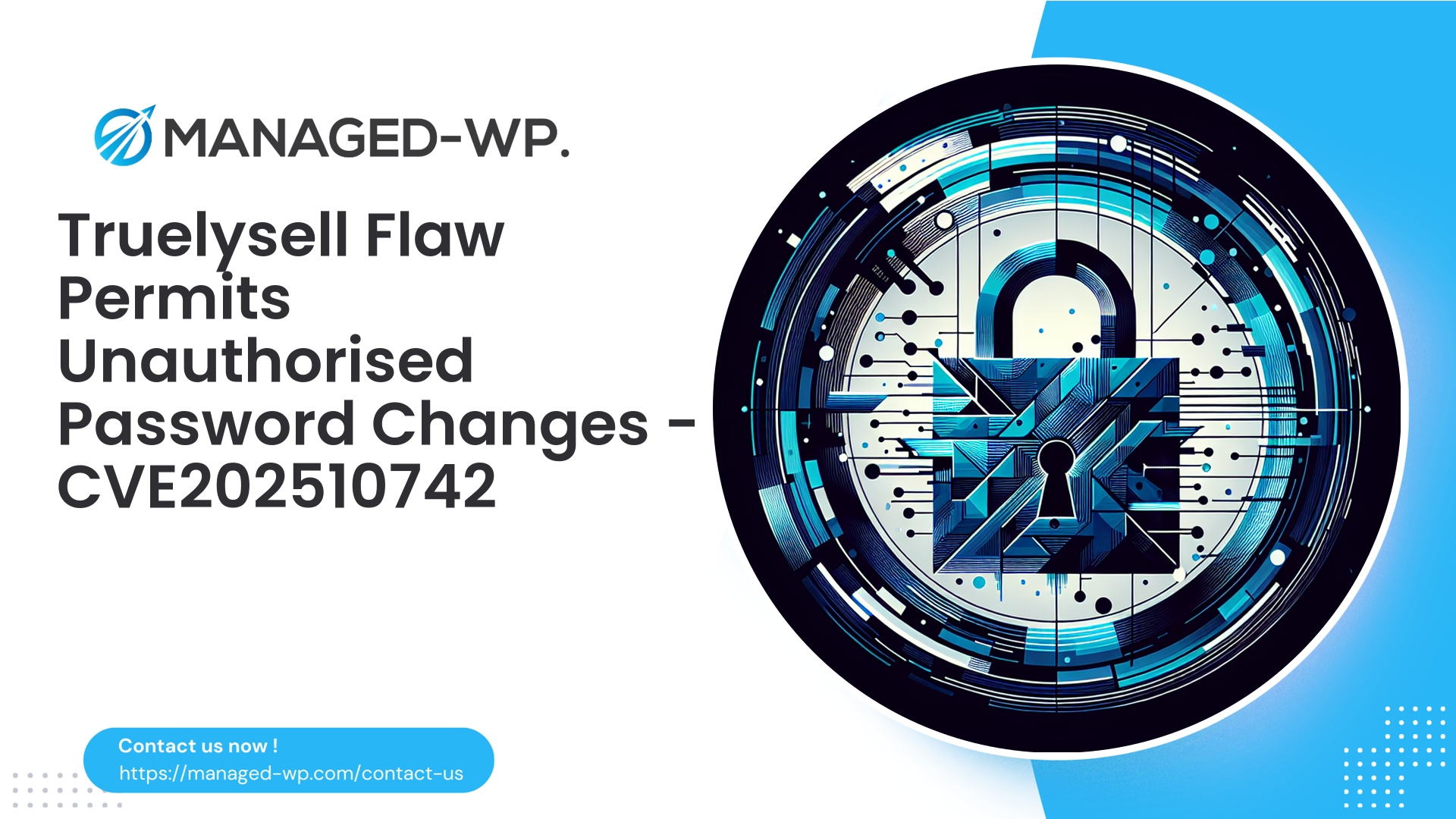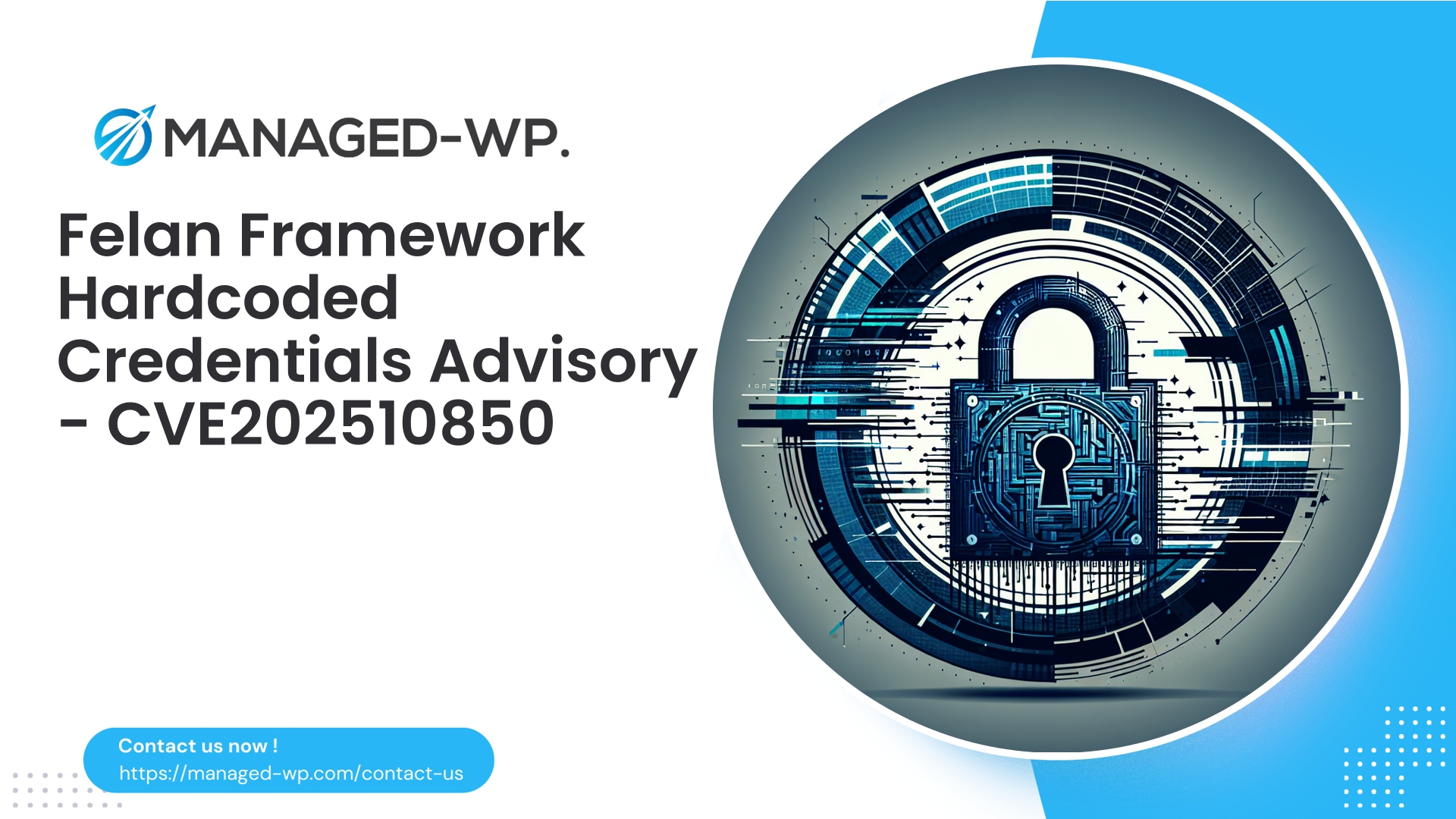| 插件名称 | Truelysell Core |
|---|---|
| 漏洞类型 | 未经身份验证的密码重置 |
| CVE编号 | CVE-2025-10742 |
| 紧急 | 批判的 |
| CVE 发布日期 | 2025-10-16 |
| 源网址 | CVE-2025-10742 |
紧急:Truelysell Core(<= 1.8.6)— 未经身份验证的任意用户密码更改(CVE-2025-10742)
最后更新时间: 2025年10月16日
执行摘要
- Truelysell Core WordPress 插件版本 <= 1.8.6 存在严重的身份验证漏洞 (CVE-2025-10742)。
- 该漏洞的 CVSS 评分为 9.8,允许未经身份验证的攻击者重置任何用户(包括管理员)的密码。
- 目前厂商尚未发布官方补丁;必须立即采取遏制和缓解措施。
- 本简报概述了风险概况、检测方法、遏制策略、缓解方案、事件响应步骤,以及 Managed-WP 的安全解决方案如何保护您的环境。
为什么这种漏洞需要立即关注
此漏洞允许攻击者在无需任何身份验证的情况下强制重置任何 WordPress 用户帐户的密码。管理员帐户是主要目标,因为成功利用此漏洞即可获得对网站的完全控制权。攻击者可以部署后门、窃取数据、恶意修改内容,或利用被攻破的网站发起更广泛的攻击。
鉴于该漏洞易于利用且后果极其严重,任何运行 Truelysell Core 1.8.6 或更早版本的组织都必须优先考虑紧急响应和风险控制程序。
事件概述及公开披露
CVE-2025-10742 漏洞于 2025 年 10 月 16 日公开披露。该漏洞指出 Truelysell Core 插件的密码重置机制存在身份验证绕过缺陷。截至目前,尚未有厂商发布补丁,这意味着自动化扫描程序和真实攻击者极易利用此漏洞。
攻击向量和实际利用场景
典型的攻击流程包括:
- 通过自动化扫描和僵尸网络识别运行存在漏洞的插件版本的 WordPress 安装。
- 向插件的密码重置端点发送精心构造的 HTTP POST 请求,而无需有效的用户凭据。
- 插件会处理请求,更新目标用户的密码。
- 攻击者随后会访问被入侵的帐户(通常是管理员帐户),从而获得对网站的完全控制权。
- 随后会发生植入后门、修改网站内容、SEO垃圾邮件和数据窃取等恶意活动。
一旦攻击工具公开传播,大规模攻击活动可以在数小时内迅速攻陷数千个网站,这更加凸显了缓解措施的紧迫性。
网站所有者优先响应检查清单
- 评估暴露情况
- 识别运行 Truelysell Core 插件版本 1.8.6 或更早版本的站点。
- 使用管理工具或 WP-CLI 进行多站点库存管理。
- 立即遏制
- 在修复完成之前,请停用 Truelysell Core 插件。
- 如果插件停用影响到所需功能,请通过维护模式和 IP 白名单限制网站访问。
- 凭证管理
- 将所有管理员密码重置为强密码、唯一密码。
- 轮换受影响站点上存储的 API 密钥和其他敏感凭证。
- 强制所有特权用户帐户重置密码。
- 启用强身份验证
- 立即对所有管理员级用户实施双因素身份验证(2FA)。
- 发现并调查剥削迹象
- 分析访问日志,查找针对插件端点的异常 POST 请求。
- 审核新增管理员用户,以及用户或站点配置表中的意外更改。
- 对文件和数据库进行恶意软件扫描和完整性检查。
- 部署虚拟补丁
- 应用 Web 应用程序防火墙 (WAF) 规则阻止利用此漏洞的流量。Managed-WP 提供针对此漏洞的紧急虚拟补丁。
- 避免高风险修复
- 未经彻底检查,切勿从完整性未知的备份中恢复数据。
- 如果怀疑系统遭到入侵,请咨询事件响应专家。
短期缓解措施(非技术性管理指南)
- 通过 WordPress 管理后台停用存在漏洞的插件,或者重命名服务器上的插件文件夹以强制禁用它。
- 使用 Web 服务器规则或 .htaccess 限制对插件端点的访问,以最大限度地减少攻击面。
- 限制 POST 请求速率并阻止表现出攻击行为的可疑 IP 地址或地理位置。
- 尽可能限制对 WordPress 管理员登录页面的访问,仅允许受信任的 IP 地址访问。
以下是限制对易受攻击插件路径的 POST 请求的 Apache .htaccess 代码片段示例:
RewriteEngine On RewriteCond %{REQUEST_METHOD} POST RewriteCond %{REQUEST_URI} /wp-content/plugins/truelysell-core/ [NC] RewriteRule .* - [F,L]
根据网站日志自定义 URI 路径,并在生产部署之前在测试环境中测试更改。
虚拟补丁和Web应用程序防火墙(WAF)策略
在官方插件更新缺失的情况下,通过WAF进行虚拟修补可以立即形成一道抵御攻击的保护屏障。主要策略包括:
- 阻止未经身份验证的 POST 请求访问插件的密码重置端点,除非请求附带有效的 WordPress nonce。
- 拒绝未经授权、缺少正确引用或身份验证的用户数据更改请求。
- 对针对用户凭证的重复可疑请求进行速率限制。
概念性 ModSecurity 规则示例:
# 阻止未经身份验证的向 Truelysell 密码更改端点发送 POST 请求。安全规则 REQUEST_METHOD "POST" "chain,deny,status:403,msg:'阻止未经身份验证的 Truelysell 密码更改尝试',id:1001001,phase:2,t:none" 安全规则 REQUEST_URI "@contains /wp-content/plugins/truelysell-core/" "chain" 安全规则 &REQUEST_HEADERS:Cookie "@eq 0" "chain" 安全规则 REQUEST_BODY "@rx (password|user_pass|new_password|reset_password)" "t:none"
确保规则设置精准,避免误报。如需自定义 WAF 配置和紧急虚拟补丁方面的帮助,请联系 Managed-WP 支持团队。
开发者级别临时补丁(高级)
具备 PHP 编辑能力的开发者可以在插件的密码重置处理文件中添加提前退出机制,以阻止未经身份验证的 POST 请求:
这是一个临时的紧急封锁措施,必须经过彻底测试,并在正式补丁发布后移除。
检测指南——日志和数据库指标
- 查找针对插件路径但没有有效登录 cookie 的 POST 请求。
- 监控意外的密码更改或具有管理员角色的新用户帐户。
- 搜索文件系统异常:上传文件中新增的 PHP 文件、被修改的插件文件。
- 审核可能表明存在持久性的计划任务。
WP-CLI 必备命令:
wp user list --fields=ID,user_login,user_email,roles wp user update admin --user_pass='NewStrongPassword!2025' find /path/to/wordpress -type f -mtime -7 -print
将当前数据库转储文件与干净的备份文件进行比较,以检测未经授权的更改。检查 Web 服务器访问日志,查找可疑的请求模式。
事件响应手册
- 隔离受影响资产: 如果怀疑网站遭到入侵,应将其置于维护或离线模式。
- 保存取证数据: 在进行任何更改之前,请先进行完整备份并导出相关日志。
- 消除威胁载体: 禁用存在漏洞的插件,并轮换凭据和 API 密钥。
- 识别持久化机制: 查找未知管理员帐户、修改过的文件或后门脚本。
- 消除威胁: 从可信来源清除或重新安装受损组件。
- 恢复服务: 加强监控和访问控制,使网站恢复上线。
- 硬化: 注册 Managed-WP 的托管 WAF 和虚拟补丁服务,以获得持续保护。
如果您对安全漏洞的影响有任何疑问,请立即联系专业的事件响应专家。
长期安全战略
- 使用经过测试的自动化更新流程,保持 WordPress 核心、主题和插件的更新。
- 依靠提供虚拟补丁和威胁特征更新的托管式WAF解决方案。
- 用户角色和访问权限应遵循最小权限原则。
- 对特权用户实施强制性双因素身份验证。
- 利用强大的备份解决方案,包括异地存储和定期恢复测试。
- 部署文件完整性监控以检测未经授权的更改。
- 实施严格的密码策略并安全地管理凭据。
- 通过减少攻击面、保护文件权限以及限制不必要的 PHP 执行来强化服务器环境。
Managed-WP 如何在漏洞事件期间为您提供支持
Managed-WP 提供分层防御策略,即使官方供应商补丁缺失,也能主动保护 WordPress 网站免受新兴威胁的侵害。
功能包括:
- 持续更新的托管防火墙,提供针对关键漏洞的紧急虚拟补丁。
- 自定义 Web 应用程序防火墙规则,阻止针对易受攻击的插件端点的未经身份验证的请求。
- 集成恶意软件扫描和完整性监控功能,并提供实时警报。
- 为技术团队和网站所有者量身定制的全面事件响应指南。
- 无限带宽保护,有效缓解流量攻击峰值。
如果您的网站受到 Managed-WP 的保护,我们针对 CVE-2025-10742 的紧急规则集已经激活并阻止了攻击尝试,从而在等待供应商补丁期间确保持续安全。
适用于您平台的 WAF 规则概念示例
- 阻止未经身份验证的 POST 请求:
- 检测针对 Truelysell 插件端点的 POST 方法。
- 拒绝缺少有效 WordPress nonce 的请求。
- 拒绝可疑载荷。:
- 在未经身份验证的上下文中检查请求体中是否存在“user_pass”或“new_password”参数。
- 直接阻止此类请求。
- 限速:
- 限制来自特定 IP 地址针对插件端点的过多请求。
- 推荐人验证:
- 拒绝来自您域名的缺少 HTTP Referer 标头的管理员级别请求。
为避免意外中断,在生产环境部署之前,务必在测试环境中测试新规则。
需要立即监测的入侵指标 (IoC)
- 意外添加了高权限用户帐户
wp_users. - 未经授权对关键选项进行修改
wp_options例如网站 URL 或已激活的插件列表。 - 上传目录或隐藏文件夹中存在可疑的 PHP 文件。
- 从 PHP 进程发出的到未知或可疑域的出站网络调用。
- CPU、内存或其他资源使用量出现无法用流量模式解释的峰值。
单站点恢复时间表示例
第 0 天(披露)
立即验证插件版本,停用存在漏洞的插件,启用WAF保护,并轮换管理员密码。
第一天
为取证目的执行完整备份,扫描恶意软件和未经授权的更改,删除恶意管理员帐户,重新安装干净的插件文件。
第2-3天
加强身份验证(使用双因素身份验证)、强制使用强密码、监控流量和审计日志。
第7-14天
进行彻底的恢复后审计,确保没有残留威胁;只有在官方补丁发布后才能重新启用插件,或者继续依赖托管的 WAF 保护。
事件后行动和持续安全改进
- 记录漏洞影响及已采取的应对措施。
- 审查并改进插件和网站补丁管理流程。
- 实施定期漏洞扫描、日志集中化和完整性监控。
- 制定定期专业安全评估计划。
立即开始使用 Managed-WP 的免费保护计划
立即使用我们的免费托管防火墙和WAF解决方案保护您的WordPress网站。
在进行补救措施的同时,利用 Managed-WP 的基本(免费)计划,获得必要的防火墙保护、恶意软件扫描和常见威胁的缓解措施,包括此关键漏洞。
立即注册,即可激活免费保护: https://my.wp-firewall.com/buy/wp-firewall-free-plan/
计划分解
- 基础版(免费): 托管防火墙、Web 应用防火墙、恶意软件扫描、无限带宽、针对 OWASP Top 10 漏洞的保护。
- 标准($50/年): 包含自动恶意软件清除和 IP 信誉管理功能。
- 专业版($299/年): 新增每月详细安全报告、自动虚拟补丁、专属支持和托管安全服务。
最终实用建议
- 将所有 Truelysell Core 插件实例版本 1.8.6 或更早版本视为易受攻击版本,并优先进行紧急缓解。
- 如果无法及时应用官方更新,请停用该插件。
- 更新管理员帐户凭据并强制执行双因素身份验证。
- 部署具有虚拟补丁功能的托管 WAF,以阻止未经身份验证的攻击尝试。
- 如果怀疑存在安全漏洞,请遵循详细的事件响应流程。
- 利用 Managed-WP 等托管保护服务,实现全面、持续的安全保障。
Managed-WP 安全团队的结语
在 Managed-WP,我们深知关键漏洞对 WordPress 网站运营者构成的风险。我们位于美国的安全专家团队会密切监控漏洞披露情况,并部署紧急虚拟补丁来保护您的网站,直到官方修复程序发布为止。
如果您需要协助评估您环境中的暴露情况、启动紧急保护措施或进行取证调查,我们的团队随时准备为您提供支持。
立即保护您的 WordPress 环境: https://my.wp-firewall.com/buy/wp-firewall-free-plan/
注意安全。
Managed-WP 安全团队



















